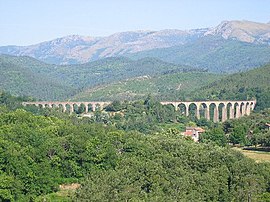Chamborigaud | |
|---|---|
 Viaduct of Chamborigaud, with Mont Lozère in the background | |
| Coordinates: 44°18′07″N 3°58′43″E / 44.302°N 3.9786°E | |
| Country | France |
| Region | Occitania |
| Department | Gard |
| Arrondissement | Alès |
| Canton | La Grand-Combe |
| Intercommunality | Alès Agglomération |
| Government | |
| • Mayor (2020–2026) | Émile Corbier[1] |
| Area 1 | 17.86 km2 (6.90 sq mi) |
| Population (2021)[2] | 887 |
| • Density | 50/km2 (130/sq mi) |
| Time zone | UTC+01:00 (CET) |
| • Summer (DST) | UTC+02:00 (CEST) |
| INSEE/Postal code | 30080 /30530 |
| Elevation | 259–887 m (850–2,910 ft) (avg. 329 m or 1,079 ft) |
| 1 French Land Register data, which excludes lakes, ponds, glaciers > 1 km2 (0.386 sq mi or 247 acres) and river estuaries. | |
Chamborigaud (French pronunciation: [ʃɑ̃bɔʁiɡo]; Occitan: Chambonrigaud) is a commune in the Gard department in southern France.
The village is known for its stunning railway viaduct, designed by Charles Dombre, the construction of which ended in 1867. Unlike most other bridges of this type, the curve of the Viaduct of Chamborigaud faces upstream.
The road bridge crossing Luech river has collapsed in March 2024. [3] One of the bridge's arches collapsed under the weight of a street-sweeper lorry. Road D906 between Langogne and Alès was left interrupted, which could have damaged the tourism industry in and around Chamborigaud. A temporary bridge has been installed downstream of the collapsed bridge and was opened in May 2024. [4]
- ^ "Répertoire national des élus: les maires". data.gouv.fr, Plateforme ouverte des données publiques françaises (in French). 2 December 2020.
- ^ "Populations légales 2021" (in French). The National Institute of Statistics and Economic Studies. 28 December 2023.
- ^ Bridge in south of France collapses: Lorry falls with it (Engels) ConnexionFrance (news in English), published on 19th of March 2024, retrieved on 30th of March 2024 (and archived: https://archive.today/20240330012627/https://www.connexionfrance.com/article/French-news/PHOTOS-Bridge-in-south-of-France-collapses-lorry-falls-with-it
- ^ Pont de Chamborigaud ouvert Drone images made by "Caillou des Cévennes" of bridge opening, published 3rd of May 2024, consulted 23rd of May 2024



